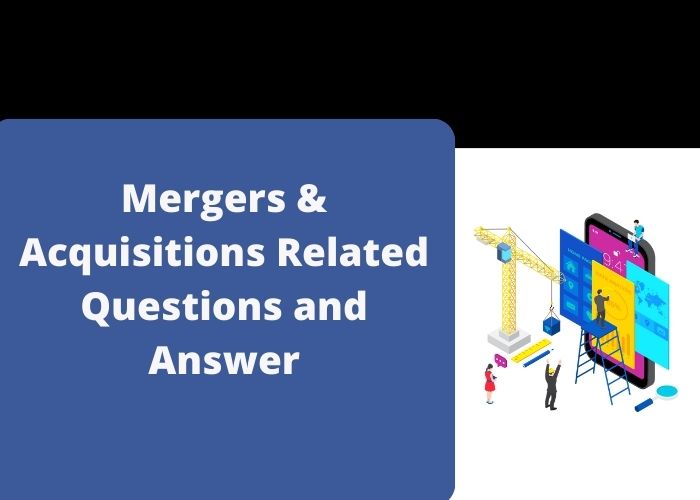1. What is a Merger?
A merger is a transaction in which two companies combine to form a single entity. It can also refer to the process of combining two companies, or the resulting combined entity.
2. What is an Acquisition?
An acquisition is a transaction in which one company takes ownership of another company. The acquiring company typically pays either cash or shares of its own stock for the target company.
3. What is the difference between a merger and an acquisition?
The primary difference between a merger and an acquisition is that in a merger, two companies combine to form a new entity, while in an acquisition, one company takes ownership of another company.
4. What is a Reverse Merger?
A reverse merger is a type of transaction in which a private company acquires a publicly-traded shell company. The private company then assumes the shell company’s publicly traded status, becoming a publicly traded company without going through an initial public offering (IPO).
5. What is a Forward Merger?
A forward merger is a type of transaction in which a publicly-traded company acquires a privately-held company. The publicly-traded company then assumes the privately-held company’s assets, liabilities, and other aspects of its business.
6. What is a Horizontal Merger?
A horizontal merger is a type of transaction in which two companies in the same industry combine to form a larger entity. The resulting combined entity has increased market power and can benefit from economies of scale.
7. What is a Vertical Merger?
A vertical merger is a type of transaction in which two companies in different but related industries combine to form a larger entity. The resulting combined entity can benefit from increased economies of scale and scope.
8. What are the benefits of a Merger or Acquisition?
The benefits of a merger or acquisition can include increased market power, cost savings, improved efficiency, increased revenue, increased customer base, and increased access to new products and services.
9. What are the risks of a Merger or Acquisition?
The risks of a merger or acquisition can include disruption to existing operations, regulatory scrutiny, loss of key personnel, potential conflicts of interest, and cultural mismatch.
10. What is a Synergistic Merger?
A synergistic merger is a type of transaction in which two companies combine to form a larger entity that is expected to be more profitable than either of the individual companies. This is typically achieved through cost savings, increased efficiency, and improved market power.
11. What is a Conglomerate Merger?
A conglomerate merger is a type of transaction in which two companies in unrelated industries combine to form a larger entity. The resulting company can benefit from increased diversification and cost savings.
12. What is a Reverse Stock Split?
A reverse stock split is a type of transaction in which a company reduces the number of its outstanding shares, resulting in an increase in the share price. This is often done to increase the share price of a company prior to a merger or acquisition.
13. What is a Cash-Out Merger?
A cash-out merger is a type of transaction in which the shareholders of a privately held company receive cash in exchange for their shares. This is typically done to facilitate a merger or acquisition.
14. What is a Stock-for-Stock Merger?
A stock-for-stock merger is a type of transaction in which the shareholders of a privately held company receive shares of the acquiring company in exchange for their shares. This is typically done to facilitate a merger or acquisition.
15. What is a Going-Private Transaction?
A going-private transaction is a type of transaction in which a publicly-traded company delists its shares and becomes a privately-held company. This is typically done to facilitate a merger or acquisition.
16. What is a Leveraged Buyout (LBO)?
A leveraged buyout (LBO) is a type of transaction in which a company is acquired using a combination of debt and equity. The acquiring company typically obtains financing from banks and other lenders to fund the purchase.
17. What is a Management Buyout (MBO)?
A management buyout (MBO) is a type of transaction in which the existing management team of a company acquires the company. This is typically done to facilitate a merger or acquisition.
18. What is an Asset Purchase Agreement?
An asset purchase agreement is a contract between a buyer and a seller that outlines the terms and conditions of the sale of the seller’s assets. This is typically used in a merger or acquisition.
19. What is a Roll-Up Transaction?
A roll-up transaction is a type of transaction in which a company acquires a number of smaller companies in the same industry in order to create a larger entity. This is typically done to increase market power and cost savings.
20. What is a Spin-Off Transaction?
A spin-off transaction is a type of transaction in which a company’s assets, liabilities, and business operations are divided and distributed to two or more separate entities. This is typically done to facilitate a merger or acquisition.
21. What is a Pooling of Interests?
A pooling of interests is a type of transaction in which two companies combine their assets and liabilities on their balance sheets. This is typically done to facilitate a merger or acquisition.
22. What is a Joint Venture?
A joint venture is a type of transaction in which two or more companies combine their resources to pursue a common goal. This is typically done to facilitate a merger or acquisition.
23. What is a Strategic Alliance?
A strategic alliance is a type of transaction in which two or more companies collaborate to pursue a common goal. This is typically done to facilitate a merger or acquisition.
24. What is a Friendly Takeover?
A friendly takeover is a type of transaction in which the target company agrees to be acquired by the acquiring company. This is typically done to facilitate a merger or acquisition.
25. What is a Hostile Takeover?
A hostile takeover is a type of transaction in which the acquiring company attempts to acquire the target company without the consent of the target company’s board of directors.
26. What is a Tender Offer?
A tender offer is a type of transaction in which the acquiring company offers to purchase a certain percentage of the target company’s shares at a specified price. This is typically done to facilitate a hostile takeover.
27. What is a Poison Pill?
A poison pill is a defensive measure taken by a target company to make it less attractive to an acquiring company. This may involve issuing additional shares or granting shareholders the right to purchase additional shares at a discounted price.
28. What is a White Knight?
A white knight is a company or investor that is invited to make an acquisition of a target company in order to prevent a hostile takeover.
29. What is a Golden Parachute?
A golden parachute is a type of severance package that a company’s executives may receive in the event of a merger or acquisition. It typically includes a lump sum payment and other benefits.
30. What is a Lockup Agreement?
A lockup agreement is a contract between a company and its investors that restricts the sale of the company’s shares for a certain period of time. This is typically done to facilitate a merger or acquisition.




